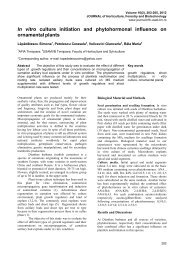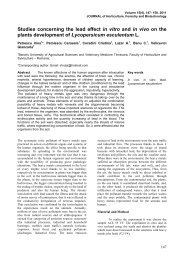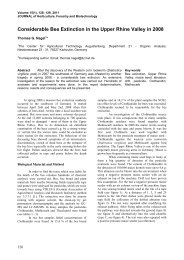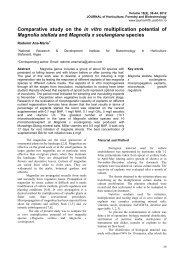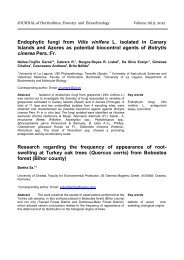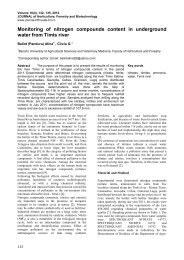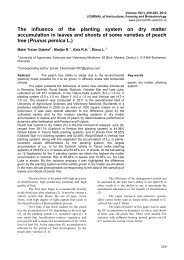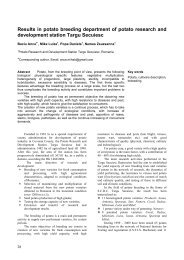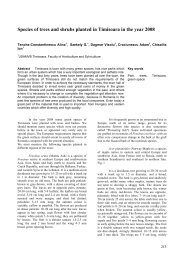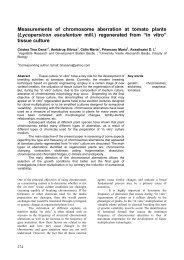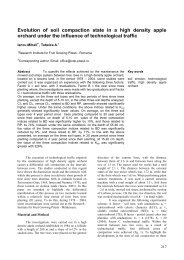Qualitative assessment of flour with a depth consistency meter and ...
Qualitative assessment of flour with a depth consistency meter and ...
Qualitative assessment of flour with a depth consistency meter and ...
You also want an ePaper? Increase the reach of your titles
YUMPU automatically turns print PDFs into web optimized ePapers that Google loves.
In principle, the apparatus is made up <strong>of</strong> atempered metal cylinder, having a certain weight <strong>and</strong>fixed on an axis immersed into dough in a recipient.The <strong>depth</strong> <strong>of</strong> the immersion is transmitted by anindicator fixed on a suspension device <strong>of</strong> the cylinderon a circular frame <strong>and</strong> is expressed in divisions from 0to 600.Auermann chose for weak <strong>flour</strong> testing wheat<strong>flour</strong> <strong>and</strong> rye <strong>flour</strong> dough; for wheat <strong>flour</strong>, he used alighter cylinder (35 g) <strong>and</strong> for rye <strong>flour</strong> a heavier one(110 g). In the apparatus, the cylinder weight is low sothat it can be sued for both normal wheat <strong>and</strong> ryedough <strong>and</strong> for rye fermentation (2, 3).To measure dough <strong>consistency</strong>, the <strong>flour</strong> to betested is kneaded <strong>with</strong> distilled water making ahomogeneous dough at laboratory temperature; thedough is let to ferment in a thermostat at 30 0 C forwheat <strong>flour</strong> <strong>and</strong> at 35 0 C for rye <strong>flour</strong> (2).The amount <strong>of</strong> <strong>flour</strong> was chosen so as thedough fills a glass recipient <strong>with</strong> thick walls <strong>and</strong> <strong>with</strong> adia<strong>meter</strong> <strong>of</strong> 6 cm <strong>and</strong> a height <strong>of</strong> 7 cm. To prevent thedough surface from drying in the thermostat, it was setin a capsule or in a crystallisator adding a small amount<strong>of</strong> water.Together <strong>with</strong> the dough, we introduce intothe thermostat the cylinder <strong>of</strong> the <strong>consistency</strong> <strong>meter</strong>which is unscrewed for its temperature to equal that <strong>of</strong>the dough. After fermentation, the dough is tested <strong>with</strong>the cylinder brought to the dough temperature.Results <strong>and</strong> DiscussionsThe testing conditions have been developedseparately for the wheat <strong>flour</strong> dough <strong>and</strong> separately forthe rye <strong>flour</strong> dough.a) Wheat <strong>flour</strong>For testing, we have chosen the T 650 type <strong>of</strong><strong>flour</strong>, preparing a dough from 130 g <strong>of</strong> <strong>flour</strong> 14%moisture <strong>with</strong> water addition corresponding to aviscosity <strong>of</strong> 60%. If the <strong>flour</strong> has a higher or a smallermoisture than 14%, then the amount <strong>of</strong> water should berecalculated depending on <strong>flour</strong> moisture so that for100 g <strong>of</strong> dry substance made <strong>of</strong> <strong>flour</strong> we add 86 ml <strong>of</strong>water. We can use the formula:1.3 x <strong>flour</strong> dry substance x 0.86 – 1.3 x <strong>flour</strong>moistureor:1.118 x <strong>flour</strong> dry substance – 1.3 x <strong>flour</strong>moisture.We tried different dough consistencies <strong>of</strong>dough <strong>with</strong> viscosity 55%, 60%, <strong>and</strong> 63%, since meanviscosity <strong>of</strong> panification <strong>flour</strong> varies around 60%. Moreconsistent dough proved improper because <strong>of</strong> the small<strong>depth</strong> <strong>of</strong> the cylinder <strong>and</strong> <strong>of</strong> the difficulties <strong>of</strong>preparation; likewise, results were not satisfactory inless consistent dough <strong>with</strong> a viscosity <strong>of</strong> about 70%because <strong>of</strong> the difficulty <strong>of</strong> preparation.Less consistent dough should be tested <strong>with</strong> alighter cylinder adapted to the task. The immersion<strong>depth</strong> <strong>of</strong> the body was measured for each minute for 5minutes <strong>of</strong> which the most decisive was the <strong>depth</strong>measured after the first minute. For testing, we used 4high quality wheat samples milled in an experimentalmill <strong>of</strong> the 650 type. In these samples, we alsomeasured for comparison milling qualities (toughness,moisture) <strong>and</strong> panification qualities. Results are shownin Table 1.Umiditate%The immersion <strong>depth</strong> <strong>and</strong> milling qualities (toughness, moisture) <strong>and</strong> panification qualitiesDuritate12,43 Semidură12,33 Dură12,60 SemidurăFineţeafăiniiFoartefinăSemigrişatăSemigrişatăGluten umedraportat lasubstanţa uscată35,4036,9635,4712,51 Moale Fină 30,86Caracteristicileglutenului:elasticitatea,alungirea sicapacitatea deumflare in cmşi ml4101648205101631112R<strong>and</strong>amentulînmlVâscozitatea%361 67,3347 65,7338 64,3350 59,1Produse depanifiicaţie,culoare,suprafaţă,înălţimea, mmBrun închis,netedă 58Brun închis,netedă 53Brun închis,netedă 52Brun deschiscrăpată puternic50Table 1Nr. deordine1234Table 2 shows the values read <strong>with</strong> the<strong>consistency</strong> <strong>meter</strong> after dough fermentation for 1.2 to 3hours for a duration <strong>of</strong> 5 minutes. Fermentation wascontrolled successively hour after hour, to see thevariation <strong>of</strong> the dough <strong>consistency</strong>.102



